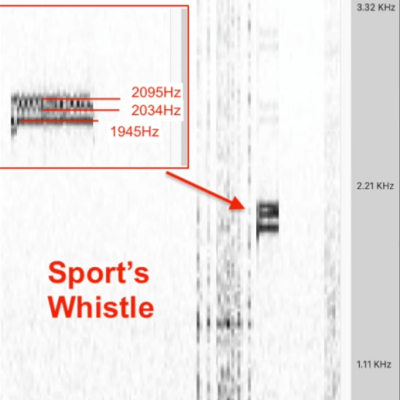Sound chips from back in the day were capable of much more than a few beeps and boops, and [InazumaDenki] proves it in a video recreating recognizable real-world sounds with the AY-3-8910, a chip that was in everything from arcade games to home computers. Results are a bit mixed but it’s surprising how versatile a vintage sound chip that first came out in the late 70s is capable of, with the right configuration.

Chips like the AY-3-8910 work at a low level, and rely on being driven with the right inputs to generate something useful. It can generate up to three independent square-wave tones, but with the right approach and setup that’s enough to get outputs of varying recognizability for a pedestrian signal, bird call, jackhammer, and referee’s whistle.
To recreate a sound [InazumaDenki] begins by analyzing a recording with a spectrogram, which is a visual representation of frequency changes over time. Because real-world sounds consist of more than just one frequency (and the AY-3-8910 can only do three at once), this is how [InazumaDenki] chooses what frequencies to play, and when. The limitations make it an imperfect reproduction, but as you can hear for yourself, it can certainly be enough to do the job.
How does one go about actually programming the AY-3-8910? Happily there’s a handy Arduino AY3891x library by [Andreas Taylor] that makes it about as simple as can be to explore this part’s capabilities for yourself.
If you think retro-styled sound synthesis might fit into your next project, keep in mind that just about any modern microcontrollers has more than enough capability to do things like 80s-style speech synthesis entirely in software.
















And now it’s sound chips on motherboards.
SN76477 is the best ever sound generator IC. The most fun I’ve ever had as a kid with it on a breadboard. Also used in Space Invaders arcade game circa 1978.
Yeah it is a lot of fun to fiddle around with one on a breadboard and build yourself a little synth, highly recommend
Check out the tune-
“After I said goodnight” by Kevin Braheny Fortune
There was half-decent software speech synthesis in the ’80s too. !Speech on the BBC micro (SN76489)
and it was far from alone! I think the first may have been SAM (written in ’79, and released for c64, apple 2, and atari in the very early ’80s). Its developers were also behind the speech synthesis software in the original ’84 Macintosh and the Amiga.
]RECITER
Totally love this!
This little sound generator really got around. Yamaha’s YM2149, or “SSG” (which has been featured on these pages before) was a licensed clone of the AY-3-8910. There were others too, but the Yamaha one really got around – not only was it common in arcade machines, it was used in the Atari ST & TT and some MSX computers.
The plain sound generator was popular enough that Yamaha kept making variants well into the 90’s, but it didn’t stop there.
They also manufactured chips which were pin- and feature-compatible with the YM2149 but included a multichannel FM Synthesis module too, such as the YM2203 (“OPN”) and YM2608 (“OPNA”). These also became quite popular in Japanese computers and arcade machines.
on a slight tangent:
Another chip in that line, the YM2612, was responsible for the distinctive sound of music on the Sega Mega Drive/Genesis, but that design stripped out nearly all of the SSG core in order to expand its FM synthesis capabilities.
Of course, the lack of the SSG core meant the chip was no longer very good at generating sound effects! But that wasn’t a big deal for Sega, as they already wanted to include one of the SSG’s closest competitors – TI’s SN76489 chip – which they’d used in the Master System and previous consoles.
huh, a combination PCB and display plaque. Nice idea, not sure if I’ve seen it done quite like this before.
Yeah, and no mention of it on the YT link either.
(sigh!)
Hmmm.. I think I have a few of these chips around here… time to play around.